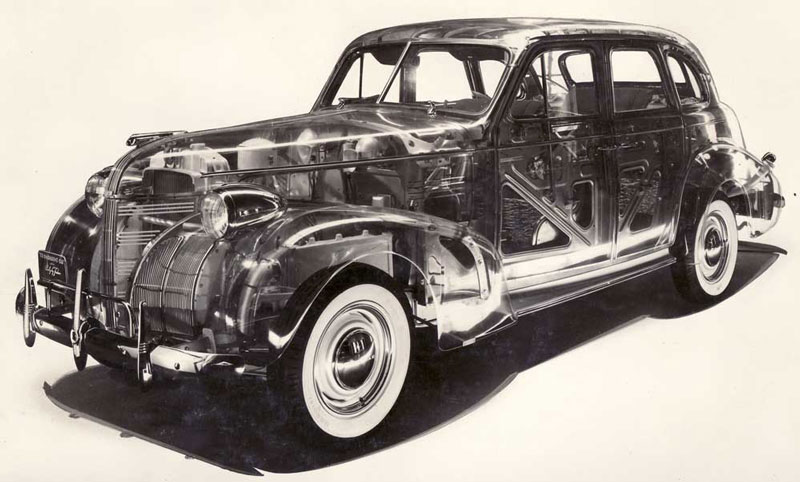

Pontiac had big news for 1939; the addition of a new, low-priced 6 cylinder series based on the Chevrolet body; Pontiac had only been marketing 1 six cylinder series during 1937 and 1938. Early sales literature listed the model line as: Deluxe Six 115, Deluxe Six 120 and the Deluxe Eight; this was later changed to Quality Six and the Deluxe Six dropped the 120 designation. The “115” and “120” refer to the wheelbase of the “A” and “B” bodies, respectively.
The Deluxe Eight utilized the “B” body and 120” chassis, which was a completely new body for 1939. The previous “B” body was set on a 122” chassis; the most noticeable feature of the new body is the significant increase in window area all around. The quick and easy way to distinguish the “A” body from the “B” body for 1939 and 1940 is to look for the fuel cap; the small body had the fill pipe on the passenger side while the larger body had the fuel fill on the drivers’ side.
There were several changes to the chassis for ’39; probably the most notable in terms of how long it remained in use, was the change to the link-parallelogram steering system. This linkage design places an idler arm opposite the steering gear box and allows for all components to be equal length from side to side. This system was used on full-size GM rear wheel drive automobiles until the final models were produced in the mid-nineties!
A new Hypoid rear axle was introduced in 1939; as you can see from the cross-section diagram, it allowed the driveshaft to be placed very low in relation to the centerline of the axle thus minimizing the hump in the floor.
“Duflex” rear springs appeared for the first time; another feature that is still in use today on light truck leaf springs. The “Duflex” spring incorporates a stiff leaf low on the stack; as the vehicle load is increased the leaves above flatten out and contact the “helper” to effectively change the spring rate.
The Safety Gearshift, introduced as an option in 1938, was improved and made standard equipment across the model lines for ’39. It featured solid rods as opposed to the previous rod/cable arrangement and connected to a re-designed transmission. This gearshift was also adjustable to fit the drivers’ reach; a highly touted feature in the sales literature.
Pontiac offered multi-beam headlights using a 3 position headlamp switch in combination with a foot-operated dimmer switch to provide both city and country levels of lighting. This was the final model year for such a system.
The 4 door convertible sedan was missing from the list of available body styles, but the Sunshine Roof option appeared on the 2 & 4 door sedan bodies only. This option was offered by Buick; and presumably available on Olds, LaSalle and Cadillac as well. It was a single year option on the “B” body only according to the Fisher Body Service Manual.
The Deluxe Eight utilized the “B” body and 120” chassis, which was a completely new body for 1939. The previous “B” body was set on a 122” chassis; the most noticeable feature of the new body is the significant increase in window area all around. The quick and easy way to distinguish the “A” body from the “B” body for 1939 and 1940 is to look for the fuel cap; the small body had the fill pipe on the passenger side while the larger body had the fuel fill on the drivers’ side.
There were several changes to the chassis for ’39; probably the most notable in terms of how long it remained in use, was the change to the link-parallelogram steering system. This linkage design places an idler arm opposite the steering gear box and allows for all components to be equal length from side to side. This system was used on full-size GM rear wheel drive automobiles until the final models were produced in the mid-nineties!
A new Hypoid rear axle was introduced in 1939; as you can see from the cross-section diagram, it allowed the driveshaft to be placed very low in relation to the centerline of the axle thus minimizing the hump in the floor.
“Duflex” rear springs appeared for the first time; another feature that is still in use today on light truck leaf springs. The “Duflex” spring incorporates a stiff leaf low on the stack; as the vehicle load is increased the leaves above flatten out and contact the “helper” to effectively change the spring rate.
The Safety Gearshift, introduced as an option in 1938, was improved and made standard equipment across the model lines for ’39. It featured solid rods as opposed to the previous rod/cable arrangement and connected to a re-designed transmission. This gearshift was also adjustable to fit the drivers’ reach; a highly touted feature in the sales literature.
Pontiac offered multi-beam headlights using a 3 position headlamp switch in combination with a foot-operated dimmer switch to provide both city and country levels of lighting. This was the final model year for such a system.
The 4 door convertible sedan was missing from the list of available body styles, but the Sunshine Roof option appeared on the 2 & 4 door sedan bodies only. This option was offered by Buick; and presumably available on Olds, LaSalle and Cadillac as well. It was a single year option on the “B” body only according to the Fisher Body Service Manual.
Pontiac used the new wonder material, “Plexi-glass”, to create a stunning show car in honor of the 1939 World’s Fair. The “Plexi-glass” Pontiac proved such a sensation that a 1940 model was done as well. The ’40 was owned for many years by long-time ETC member Don Barlup and has been the subject of several magazine articles.
The “Plexi-glass” Pontiacs were both functional automobiles and could be driven. I had a conversation with Don year’s ago and remember him telling me that you couldn’t run the engine very long before the heat would cause the hood to sag! He also said that the body was highly susceptible to scratching so that everything thrown up by the tires damaged the inner surfaces of the fenders. Those white tires weren’t going to look good for long either!
Plastics were new in the late-thirties and weren’t by any means considered to be cheap or shoddy. Sales literature from most automobile manufacturers’ touted the use of plastic in their cars. Unfortunately these early plastic compounds proved to be less than durable, primarily due to a lack of ultraviolet light protection, and it didn’t take long for the buying public to view plastic as “cheap” when applied to automobile interiors.
The sales follow-up envelopes offer an insight into how seriously automobiles were being marketed and how effective it was to pay attention to the little details. It gave the sales staff legitimate reason to continue “tracking” each new Pontiac and gauge their satisfaction with the product. Ideally, any complaint(s) mentioned at the time would be quickly dealt with to insure a future sale.
This attention to detail wasn’t limited to the Sales and Marketing departments at Pontiac; the same was true for Engineering. The automobiles were constantly being upgraded with minor improvements, many of which were deceptively simple and inexpensive but paid big dividends in the performance and durability of the product. The direct comparison with competing automobiles highlights many of these features. I chose the Mercury and Dodge products as these were direct competition for Pontiac as offered by Ford and Chrysler.
The “Plexi-glass” Pontiacs were both functional automobiles and could be driven. I had a conversation with Don year’s ago and remember him telling me that you couldn’t run the engine very long before the heat would cause the hood to sag! He also said that the body was highly susceptible to scratching so that everything thrown up by the tires damaged the inner surfaces of the fenders. Those white tires weren’t going to look good for long either!
Plastics were new in the late-thirties and weren’t by any means considered to be cheap or shoddy. Sales literature from most automobile manufacturers’ touted the use of plastic in their cars. Unfortunately these early plastic compounds proved to be less than durable, primarily due to a lack of ultraviolet light protection, and it didn’t take long for the buying public to view plastic as “cheap” when applied to automobile interiors.
The sales follow-up envelopes offer an insight into how seriously automobiles were being marketed and how effective it was to pay attention to the little details. It gave the sales staff legitimate reason to continue “tracking” each new Pontiac and gauge their satisfaction with the product. Ideally, any complaint(s) mentioned at the time would be quickly dealt with to insure a future sale.
This attention to detail wasn’t limited to the Sales and Marketing departments at Pontiac; the same was true for Engineering. The automobiles were constantly being upgraded with minor improvements, many of which were deceptively simple and inexpensive but paid big dividends in the performance and durability of the product. The direct comparison with competing automobiles highlights many of these features. I chose the Mercury and Dodge products as these were direct competition for Pontiac as offered by Ford and Chrysler.
Comparison literature: De Luxe Eight vs Ford Mercury De Luxe Six vs Dodge Special Six
Features-Models-Ephemera Color Combinations
Features-Models-Ephemera Color Combinations

Special thanks to Jim Barnhart of Rossford, Ohio for providing us with a sizable collection of literature for this article.